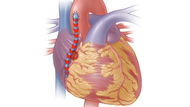Coronary Artery Bypass Surgery: Your Medical Team
Topic Overview

A team of surgeons, nurses, and other medical staff will participate in your coronary artery bypass graft (CABG) surgery. Each team member has a specific set of responsibilities before, during, and after the surgery.
CABG surgery is a complex operation. It involves a great deal of technical expertise and precision. The medical professionals in the operating room during your surgery will be specially trained in performing the CABG procedure. Also, your medical team will probably have worked together as a team many times in the past.
You might have a team that helps you decide whether to have bypass surgery. This team could be your cardiac surgeon and another cardiologist, called an interventional cardiologist, who does angioplasty procedures. They can help you understand your treatment options and help you make a decision.
The exact team will differ at particular hospitals. But the medical team that performs a CABG surgery is roughly similar at all institutions.
- Surgical team: Your cardiac surgeon or surgeons and a surgical assistant will perform your CABG procedure.
- Anesthesiology team: Your anesthesiologist and a certified registered nurse anesthetist will give and monitor your anesthesia, medicines, and vital signs during the surgery.
- Nursing team: Specially trained nurses will assist the surgical team.
- Perfusionist: A certified medical technician monitors the heart-lung bypass machine.
Surgical team
You will likely first meet your cardiac surgeon at his or her office. That's where you will discuss specific aspects of your CABG surgery. Many hospitals require that two cardiac surgeons perform this kind of surgery. These surgeons lead the procedure and are responsible for performing its most intricate parts. Specifically, your surgeon will:
- Handle your heart and blood vessels.
- Graft the new blood vessels to your coronary arteries.
- Oversee all the other parts of the surgery.
All surgeries also have a surgical assistant. He or she is typically responsible for harvesting the blood vessels that will be used as graft material. This assistant will also help the surgeon with opening and closing your chest and sewing (suturing) your incision after surgery. He or she is also the person who will most regularly check on your progress as you recover.
Anesthesiology team
You will probably meet one or more members of your anesthesia team the evening before and the day of your surgery.
This team will give you the proper dose of general anesthesia so that you are unconscious during the operation.
Also, the team will monitor your vital signs. They will correct any changes in your blood pressure, heart rhythm, or blood oxygen levels with adjustments to the anesthesia and medicines you are receiving.
This team will keep you comfortable during the procedure by treating any pain associated with your CABG surgery. They will give you medicines through a tube inserted into a vein (intravenous, or IV).
Your anesthesia team is also responsible for making sure that you get enough medicine to control your pain after your surgery.
In the hours that follow surgery, a respiratory therapist will work with the anesthesia team and your surgeon. This therapist will monitor your breathing to make sure that you get enough oxygen through your ventilator. He or she will also help you come off the ventilator as soon as possible.
Nursing team
The nursing team is made up of several nurses with special training in CABG surgery. The nurses prepare you for the surgery and assist the anesthesia team in your care during the procedure. Also, they make sure that the right surgical tools are available. And they assist the surgeon with the handling of those tools.
Perfusionist
The perfusionist is a certified medical technician responsible for monitoring the heart-lung bypass machine. He or she makes sure that the machine is correctly doing the jobs of your heart and lungs during your CABG surgery.
Related Information
References
Other Works Consulted
- Gray RJ, Sethna DH (2012). Medical management of the patient undergoing cardiac surgery. In RO Bonow et al., eds., Braunwald's Heart Disease: A Textbook of Cardiovascular Medicine, 9th ed., vol. 2, pp. 1793-1810. Philadelphia: Saunders.
- Hillis LD, et al. 2011 ACCF/AHA Guideline for coronary artery bypass graft surgery: A report of the American College of Cardiology Foundation/American Heart Association Task Force on Practice Guidelines. Circulation, 124(23): e652-e735.
Credits
ByHealthwise Staff
Primary Medical Reviewer Rakesh K. Pai, MD - Cardiology, Electrophysiology
Martin J. Gabica, MD - Family Medicine
Adam Husney, MD - Family Medicine
Specialist Medical Reviewer David C. Stuesse, MD - Cardiac and Thoracic Surgery
Current as ofDecember 6, 2017
- Top of Page
Next Section:
Related Information
Previous Section:
Topic Overview- Top of Page
Next Section:
References
Previous Section:
Related Information- Top of Page
Next Section:
Credits
Previous Section:
References- Top of Page
Current as of: December 6, 2017




